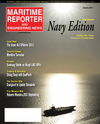
Page 9: of Maritime Reporter Magazine (January 2011)
International Naval Technology
Read this page in Pdf, Flash or Html5 edition of January 2011 Maritime Reporter Magazine
January 2011 www.marinelink.com
Complex. The forecast is for the foundations to be laid and construction work to begin in May 2011 and the shipyard should be in full operation by the first quar- ter of 2013. The final decision was made due to strate- gic factors such as the possibility of increasing the quay length by around 70% and also that the Açu lo- cation in Rio de Janeiro has a centralized geographic position between the three star oil basins in Brazil (Campos, Santos and Espirito Santo) and the synergy that the shipyard will have with other infrastructure projects being implemented in Açu, such as steel mills.
How long until the shipyard is operational?
The whole construction process take a little over two years, but there are partial deliveries, so that within a little more than one year we will receive the whole in- dustrial area and fitting area, that is warehouses, with industrial production lines, where we can begin cut- ting and welding panels and begin to build the top side modules. While this goes on we continue working on the dry dock and the quay. After the second year we re- ceive the finished dry dock and part of the quay, so the shipyard is working and ready to integrate the mod- ules. A few months later we receive the rest of the quay. So within a little over one year of initial con- struction the yard is partially operational and within a little over two years it is fully operational.
Have you already received the new FPSO, OSX 1?
Yes, the basic FPSO was delivered to us by the Sam- sung Shipyard in late January. It originally belonged to a company called Nexus but they went bankrupt, so we were able to buy it at a very advantageous price.
Since the FPSO was originally designed to work in the
North Sea and Samsung delivered only a basic FPSO version, we have sent it over to the Keppel shipyard in
Singapore for final outfitting and customization. They are adapting it for operations here at the Campos
Basin. Including this first FPSO, we already have four orders from OGX. We will be receiving the quotes for the second FPSO by mid of October. We will be ex- amining the proposals and negotiating with them to decide with which company we will place the order by year end. We also have orders for two wellhead platform jackets, we are working on the conceptual design for these now, and once that is done we will be quoting companies interested in building them, hope- fully by the end of the year. For the FPSO we should have all the financing sorted by the first quarter of 2011 and for the Jackets for the second or third quar- ter of 2011.
Did the $420m loan you signed with DVB and in- ternational banks have anything to do with this?
Yes it did. We acquired OSX1 using a bridge loan structure. The facility signed with DVB is the long term debt that will replace this bridge loan.
What are your views about the growth of the
Brazilian shipbuilding industry?
Besides OGX demand, one of the triggers of this de- velopment, looking through an industry point of view, is that the recent Petrobras share offer and the funds it brought in were vital, as it guarantees that all the in- vestments that were planned will go through. With this investment, there will be demand for everything re- lated to the O&G industry, such as, fixed platforms,
FPSOs, drill ships, support vessels and tankers. So we see that with this recent successful fund raising oper- ation by Petrobras, the oil industry and the shipbuild- ing industry are confident that these investments will happen. About the bulk carriers segment we can see that Brazil is increasing its ties with countries such as
China, so this will bring a big demand for all kinds of ships, mostly transports ships for products such as iron ore, grains and other commodities. As we all know
Brazil doesn´t produce only oil, it has a thriving agri- cultural and mining industry and all this will be in de- mand and will require more ships for transport.
Açu Superport: the OSX shipyard may be built on far left. $30B Orderbook
This $30borderbook allows OSX to build a shipyard with Korean standards and size. It will be a $1.7b investment in a shipyard, something never seen before in Brazil. It will be the largest shipyard of the Americas, where we will bring all of Hyundai´s technology, a highly efficient, state of the art shipyard, all thanks to this order book. Undoubtedly, it will be the most efficient shipyard in Brazil. (Photo OSX)

 8
8

 10
10
